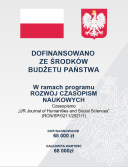Coal in Polish-Soviet economic relations
DOI:
https://doi.org/10.15584/johass.2021.3.6Keywords:
PRL, USSR, economic relations, war reparations, foreign tradeAbstract
Polish coal played an important role in economic relations between the People's Republic of Poland and the USSR. Its resources constituted an important element of the Soviet policy towards Poland. In 1946–1953, the forced deliveries of black fuel were a kind of donation. The Soviet authorities explained them with losses in war reparations as a result of the transfer of German lands on the Oder and Nysa Łużycka to Poland, with rich coal resources in Silesia. The Soviet Union also did not refrain from taking over some of the Polish coal deposits as a result of the forced correction of the borders in the east in 1951. Deliveries of "reparative" coal at lower prices brought Poland serious financial losses and inhibited the development of economic relations with Western countries. The export of coal under trade agreements concluded from 1945 was also economically unfavorable. The Soviet authorities imposed both excessive quotas and difficult financial conditions. From 1949, for this purpose, they used the price and exchange rate mechanism applied by the Council for Mutual Economic Assistance. Only in the 1960s did it become beneficial for Poland, and in the following decades it brought losses. The export of coal to the USSR, which in the 1980s amounted to 30% of total exports, caused a deficit of fuels on the domestic market, made it difficult to use the existing economic potential and maintain an adequate standard of living of the population. The political transformation after 1989, which introduced market regulations to foreign trade, led to the collapse of coal exports to the USSR.Downloads
Download data is not yet available.
Downloads
Published
2021-09-30
How to Cite
Kaliński, J. (2021). Coal in Polish-Soviet economic relations. Journal of Humanities and Social Sciences, 20(3), 93–112. https://doi.org/10.15584/johass.2021.3.6
Issue
Section
Articles
License
Copyright (c) 2021 Wydawnictwo Uniwersytetu Rzeszowskiego

This work is licensed under a Creative Commons Attribution-NonCommercial 4.0 International License.



